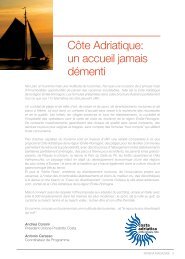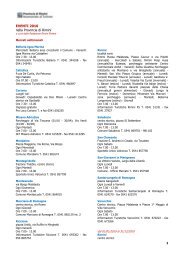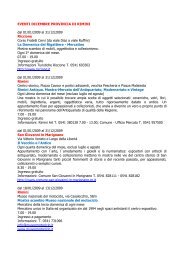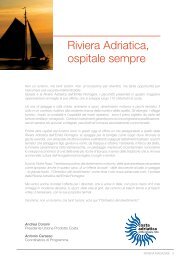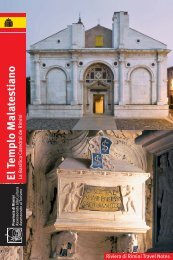Malatesta fortresses and castles
Malatesta fortresses and castles
Malatesta fortresses and castles
- No tags were found...
Create successful ePaper yourself
Turn your PDF publications into a flip-book with our unique Google optimized e-Paper software.
Introduction > The Defences of the <strong>Malatesta</strong> State8Ever since Roman times, Rimini has held sway over a broadbelt of l<strong>and</strong>, both in the plain towards Romagna <strong>and</strong> in the hillstowards Le Marche. In the Middle Ages the City-State of Riminifound itself in conflict with the various possessions of the localChurch, the Church of Rome, <strong>and</strong> the Church of Ravenna, <strong>and</strong> alsowith the numerous concessions made to monasteries <strong>and</strong> wealthyl<strong>and</strong>owners by the Archbishop of Ravenna, the Pope, <strong>and</strong> theEmperor. From the twelfth century onwards, the supremacy ofRimini over the surrounding hill country was threatened by the<strong>Malatesta</strong> family, who from their seats in Pennabilli <strong>and</strong> Verucchiowere able to keep a hold over the middle Marecchia valley, alreadydominated in its upper part by the Carpegna <strong>and</strong> Montefeltrofamilies.Conflict <strong>and</strong> concord followed one another repeatedly, untilfinally the <strong>Malatesta</strong> family took over as rulers of Rimini in thefourteenth century, <strong>and</strong> governed it in the office of Vicars of theHoly See from 1355 until the end of the fifteenth century. Foralmost two centuries the history of Rimini <strong>and</strong> the history of the<strong>Malatesta</strong> dynasty were one <strong>and</strong> the same, <strong>and</strong> the <strong>Malatesta</strong>family extended their dominion over the surrounding l<strong>and</strong>s: in LeMarche, as far as Ascoli Piceno, in Tuscany as far as Borgo SanSepolcro, <strong>and</strong> in Romagna as far as Cesena; but they neversucceeded in getting rid of their most shrewd <strong>and</strong> powerfulneighbours, the Montefeltro family. The Montefeltro dynastyprobably owed its origins, like the <strong>Malatesta</strong>, to possessionscarved out of the l<strong>and</strong>s belonging to the earldom of Carpegna,feudatories of ancient Imperial origin who ruled Mount Carpegna<strong>and</strong> much of the region. The conflict between the <strong>Malatesta</strong> <strong>and</strong> theMontefeltro families became especially bitter in the mid-fifteenthcentury when the heads of the two rival families were respectivelySigismondo <strong>and</strong> Federico, especially when Federico succeeded ininstalling his son-in-law Aless<strong>and</strong>ro Sforza as ruler of the city ofPesaro <strong>and</strong> its surrounding l<strong>and</strong>s, in 1445. Until then, Pesaro hadbeen a <strong>Malatesta</strong> possession, belonging to Sigismondo’s cousin,the inept Galeazzo <strong>Malatesta</strong>. This new state of affairs gave theterritory of Urbino access to the sea while at the same time cuttinginto two separate sections the territory of Sigismondo, which at thetime extended into Le Marche as far as Fano, Senigallia <strong>and</strong>Fossombrone.The Marecchia <strong>and</strong> Conca valleys provide many examples ofmilitary architecture from the twelfth to the fifteenth centuries.Villages fortified to a greater or lesser extent alternate with stout






